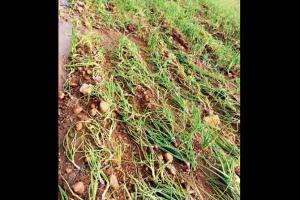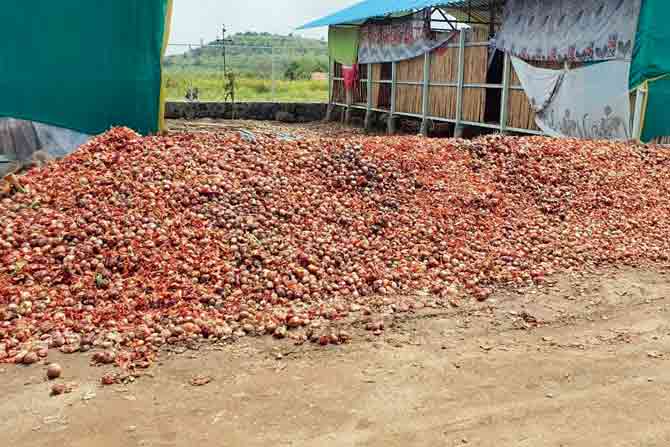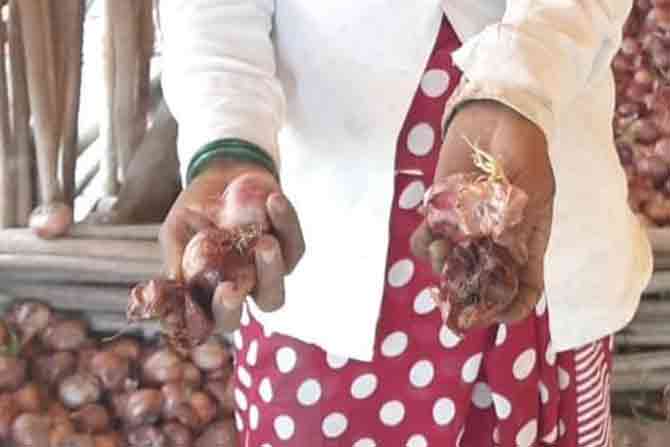With more than half of the crop and harvest destroyed by rain and disease, traders and farmers say the price is expected to soar next month and remain high until Jan 2021

The damaged onion crop in a field in Nashik
The kanda in your poha is likely to get costly by next week. Traders and farmers say onion price may soar to Rs 150 per kg after Dussehra, thanks to heavy rain and a fungal disease that have destroyed more than half of the crops and the harvest this year. Maharashtra, which caters to nearly 60 per cent of the nation's demand, has been affected the most.
ADVERTISEMENT
In Maharashtra, nearly 60 per cent of the onion crops were damaged in the rain and by anthracnose disease, which, along with blights, is continuing to create havoc in the current Kharif season. These findings were revealed in an ongoing survey by an expert team of Indian Council of Agricultural Research-Directorate Of Onion And Garlic Research (ICAR-DOGR) at Rajgurunagar in Pune district. The team is conducting the survey of onion produce in Nasik (Lasangaon), Ahmednagar, Sangamner, Pune road, etc.
Stored onions damaged too

Dr. Anand Kumar Singh
ICAR Deputy Director General Dr Anand Kumar Singh told mid-day, "As per the preliminary findings from Nashik, 40-60 per cent of Kharif fields were affected between September and October due to heavy torrential rainfall, which also caused anthracnose disease. The disease has not only infested the existing crop, but also the seedlings at the nurseries. Moreover, 40 to 50 per cent of stored onions in bamboo and dry grass sheds were also completely spoiled, leading to wastage of tonnes of onions."
When asked about the estimated loss, Dr Singh said, "We have not evaluated the losses yet, as the survey is underway and Maharashtra being the largest producer [nearly 60 per cent the of national produce come from the state], we can be certain that the damages will lead to a shortage of onion supply and therefore price hike would be inevitable, which would continue till this year end or early January 2021, when the new harvest would hit the market."
Ashok Walunj, director, Onion and Potato Market, APMC, Vashi, said, "We are anticipating the price of wholesale onion to go over R100 by next week. We won't be surprised if the retail prices hit R150 in the coming days." He also warned that the prices would continue to soar till year end.
When asked the reason for steep rise in prices, Walunj said, "Excessive rainfall in June and July has affected the onion production badly and the ongoing torrential rains have further damaged the crops, leading to heavy losses."

Onions damaged by rain, fungal disease in a godown
Explaining the production of onion, Dr Singh said, "This calendar year [2019-2020], India produced 26 million tonnes of onion, higher than the previous year's 23.28 million tonnes of onion. The onion transplantation is done thrice a year in India and the main season is Rabi for which plantation is done between November and December, and the crop is harvested from March to May, which produces nearly 195 lakh tonnes on onion. India gets its 60 per cent produce during this season."
We get the remaining 40 per cent of the produce during the two Kharif seasons. One plantation is done in June-July and the crop is harvested in October-November -- the country gets 30 lakh tonnes of onion. And for the late kharif season, the plantation is done in September-October and harvesting is done in January-February and the country gets its remaining 20 per cent of yearly produce, explained Dr Singh.
The problem this year
According to Dr Singh, the rain this year has played havoc as it affected nearly 60 per cent of the harvest that comes by October-November, along with the disease. If we receive more rain and diseases continue to spread, the remaining 40 per cent of the produce will also be impacted.
The late Kharif [September-October' plantation, which would have got fresh harvest in January and February, is also affected, as these were in nurseries for plantation and nearly 40 per cent of the nurseries were affected in Nashik, which is one of the major suppliers.
"We are closely monitoring the situation in Maharashtra. The state is the leader in onion production, so we are concerned, as any short supply scenario from traditional belts like Maharashtra, Andhra Pradesh and Haryana, will have a nationwide impact. Therefore, we are now in the process of looking for newer non-traditional ways of onion cultivation to tackle the possible future crises," explained Dr Singh.
Will import help?
The government has already put a ban on export of onions, and now the Ministry of Agriculture is contemplating importing onion. However, "if the government decides to import onions, it would take over a month for the container ship to come," highly placed sources told mid-day. "Also, India won't import onions from Pakistan and Turkey due to the present political situation, making us rely on Afghanistan or Iran or Egypt -- a decision that is still pending."
Still importing onions won't help reduce the prices, Walunj said. "The least we can import are 500 containers or so, and this is not sufficient to cater to the entire nation's requirement."
APMC officials at Onion and Potato market on Friday told mid-day, "The wholesale prices of onion at APMC varies from Rs 45 to Rs 85 per kilogram, and the expected price hike by coming week will be around 25 per cent, both in wholesale and retail price, which is estimated to shoot over Rs 150 in the coming days."
On Friday, only 68 vehicles arrived at APMC [26 trucks and 42 tempos] with 5,244 quintals of onion from Nasik Lasalgaon, Ahmednagar, Sangamner, Pune etc, as compared 80 vehicles [32 trucks and 48 tempos] with 8,240 quintals to Thursday. Before the COVID-19 lockdown, around 200 trucks and tempos would reach APMC daily on an average.
Farmer speak

Baban Fand
Baban Fand, 35, a farmer from Sarola Advai, Parner Taluka, Ahmednagar cultivates onions in his 10-acre land. He said, "Ahmednagar usually gets very little rainfall, but this year we saw heavy to very heavy rainfall, which destroyed nearly 60 per cent of my crop that was ready for harvest. Also the nursery has been affected by 40 per cent."
"It cost nearly Rs 70,000 per acre to cultivate onion and I took out a bank loan of R5 lakh bank. I am not sure if the remaining 40 per cent of my produce would remain unaffected. And I am also not sure whether my 5 tonnes of onion harvest would yield enough money to help me cover my losses," he added.
Demand to increase
Until the lockdown, the consumption of the crop was restricted to households, but now as the country is gradually reopening, eateries, restaurants and hotels are also starting to resume business. This is expected to lead to a rise in demand for onions.

Walunj said, "Next week, demand for onion will increase from hotels and catering industry, which is all set to reopen. We were so far catering to household demands, but with the additional demand from hotels and eating joints, there will be a shortage of onion supply."
Keep scrolling to read more news
Catch up on all the latest Mumbai news, crime news, current affairs, and a complete guide from food to things to do and events across Mumbai. Also download the new mid-day Android and iOS apps to get latest updates.
Mid-Day is now on Telegram. Click here to join our channel (@middayinfomedialtd) and stay updated with the latest news
 Subscribe today by clicking the link and stay updated with the latest news!" Click here!
Subscribe today by clicking the link and stay updated with the latest news!" Click here!






